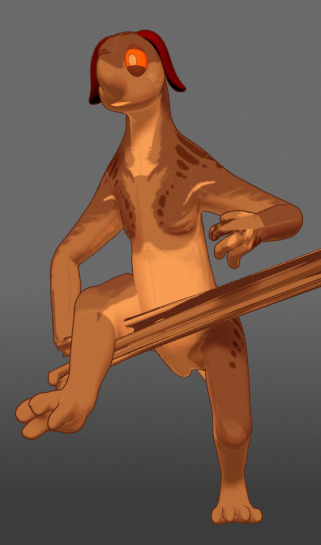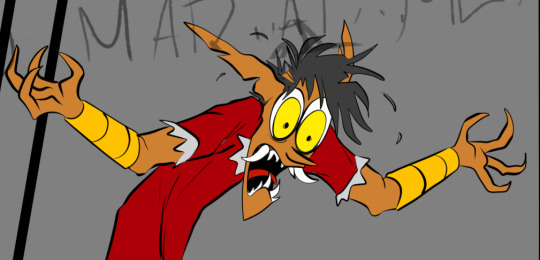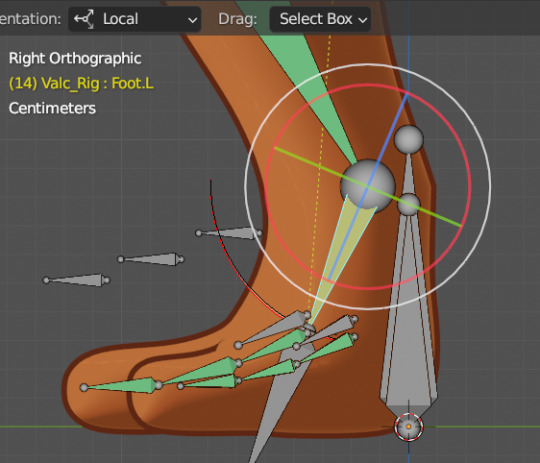#just a screenshot of a comic about sister location I'm doing
Explore tagged Tumblr posts
Text

Me and the hand unit are really going places lol
proceeds to throw him into a garbage can
#just a screenshot of a comic about sister location I'm doing#sorry it took so long#my first attempt began a month ago#and then I had an art crisis and ended up restarting#anyways#art tag#artists on tumblr#digital art#shortiebread#fnaf#five nights at freddys#fnaf fanart#illustration#fnaf sister location#sister location#fnaf sb#fnaf handunit#artwork#art
21 notes
·
View notes
Text
Think I have to call it quits to a weekly post, so instead let's just do a Blender one, because that's what at least half of it would be anyway.
So... not gonna lie, this model is looking scary good. Like, 'actually this might work on its own' sort of good.


Well... when I fix it.
The ultimate litmus test to me will be if it can replicate some of my comics expressions. Because, like, I need silly faces. Its not my comic if there arent silly faces.



I've been mostly working on the rigging, and, good news! I'm hip to drivers and custom properties now! Yeah, I have no idea why no one could explain them to me correctly. They're so simple. I 100% bet the reason it never worked was because of the local-world axis distinction and not being aware of the ability to change the axis youre working with, or that they exist at all.
Here's a neato gif I made of some progress:


By the way, that's not the gif lagging. It is actually that slow to open the mouth.
Which brings me to bad news... I think my computer is finally too weak for me to be able to do all this not-frustratingly. I built it, what, 6 years ago? I think longer even. It was a good, mid range rig, but now, if I want to upgrade, I would basically need to replace half of it because its no longer compatible with things.
On the plus side, when I do inevitably have to upgrade, my sister will finally get a computer that doesn't suck.
And it's mostly that one damn boolean on the mouth. The fast setting just... doesn't work. even having it visible and not editing it at all makes the framerate drop. And I need several more booleans for their neck holes! Let alone having multiple characters talking. It's not impossible, just, frustrating. And if it's frustrating, It simply isn't viable as an alternative to screenshotting the models and drawing over them.
Gonna put a cut for rambling about drivers, aka boring number crunching. It's actually pretty fun to me but that's because I'm a wierdo who thinks naming several hundred bones is a relaxing task.
So, drivers. They're kinda sick. I really wanna explain that foot curl cuz mmmm. damn. sooo satisfying. I have it even better than that gif now, it even curls inward so the outer toes are more thumblike.
Well first off what's a driver you may ask. Heck even if you do blender stuff, drivers seem not very well-explored. Basically a driver is an instruction set to tell one property to change, based on another property. For the foot, i have it so the foot bones' position on the upward axis (y location) changes the x rotation of the foot bones.

This is what that looks like. Purple is the property I want to change, var and proxyrot are the 'changers'. They *drive* the change.
Tbh I'm oversimplifying the above but most of the extra stuff is for convenience. Instead of the foot itself raising, the 'footsplay' bone follows it, but with a fixed axis, just to make it more predictable. And since adding a driver makes a given property uneditable, theres another bone riiiight above the bone being driven that only exists to let you adjust it manually. I called it a proxy bone, but I forget if proxy is the right word. It felt right.
Above, you can see the expression that tells it what to do when. It's python, which, I barely know, so I just copy and pasted how to do a minimum and max value. To put it in words, if the foot is off the ground, increase x until it gets to 0.3. If the foot is below the ground, don't change x at all. Plus, whatever the proxy bone is doing.
Thankfully I only need a proxy bone for each toe; the rest of the curling is done by copying the rotation to the next bone, then to the next next bone... (If you hold your finger out straight, rotate it a bit, rotate the next joint by about the same... you see it makes a 'curl' effect) Since that uses a modifier and not a driver, it's also adjustable, so the rest don't need proxy bones!
The bones to rotate all the toes at a given joint (I fixed them, you can see more below) are basically the same thing. Copy its rotation to all the joints. Just a liiiitle quicker than selecting them individually, setting the rotation to be based on their individual origins, and rotating.
Why did I never understand how to make these work? Mostly that 'space' option. While I'm pretty sure I understood what the local space was, here's the thing:


In this case it's not a big difference because both have the same x axis (red), but... the global (world) axes and local (local) axes of bones and various objects can be very different from each other. In this case, imagine if I wanted it to rotate on the y (green) axis. They're practically swapped! I use this dropdown soooo much and afaik I just, happened to goof around with it one day, no one ever mentioned it in any tutorials.
I want to make a blender tutorial so much...
You're already down here so I'll ramble about that.
Basically, I believe most people here at least who want to get into 3d are 2d artists. This kinda sucks cuz... I'll be real a lot of the people making these tutorials are the techbro sort... That's not per se a bad thing, it's wonderful if people who have no prior artistic experience find that 3d is their calling, but... It's often a specific sort of person. They want to make movies, realistic environments, maybe they make videos and want to do cgi for it, motion tracking, etc. etc.
To get to the point, I think most people here want to make their 2d art into 3d art. That's all. And when all the common 101 tutorials are photorealistic donuts, environments, and they get bored and go straight to a lot of dense non-beginner character modelling, sculpting, rigging tutorials... people think they can't do it, it's boring, it's hard, etc.
So my idea is a complete beginner character tutorial.
First off, the basics of blender. Maybe. To be honest I think introducing new concepts organically is better but honestly, a lot of tutorials go over moving rotating scale... and don't mention wtf all the panels are? Blender is so fucking scary looking at the start. I used to think 'dont worry, 90% of it you'll never touch' but to be honest? The biggest hurdle for me was uh. Learning the 90% no one ever touches. I think there's a big setback of teaching the bare minimum and then you try to do something yourself and you can only work with the bare minimum you were shown.
Perhaps if I recorded a really long vid of me explaining things I think are important to understand, then cutting out any that come up naturally. Then you'd still get the things I think are important, without doubling up the the ever annoying 'explains a thing 5 minutes in then actually uses it assuming you remember what it is an hour later'.
But! What would it be? I want to cover 1. 2d concept! It's one thing to want to make something 3d but I think no one ever mentions the sort of considerations that should go into your concepts... T-posing is really important! I think reference sheets are great practice for this but there are still some considerations that you only think about way too late, like 'is the mouth open or closed by default' and 'should you model necks straight out or curved by default'.
So you have a 2d concept. You know what you want it to do and have drawn it accordingly. How tf to model. (I basically just model nowadays so I wouldnt cover sculpting... but I'd mention it and give enough breadcrumbs to get started on experimenting with it... and lowkey recommend sculptris cuz its soooo cute as an intro to sculpting even if its limited) here id cover basic movement, the neglected local, world, normal concepts, pivot point options also often neglected,,, I'd probably separate sections into 'the actual tutorial' and 'things that you probably want to know' just in case people only want the meat and prefer to tackle problems as they come.
I'd also cover important modifiers like subdiv, solidify, mirror, also some wierd but useful ones like shrinkwrap and array.
Materials, shading, I'm not sure how I'd go about those. Since it's a character tutorial, probably at least how to add a texture, how to do transparency, errr. UV's are a big one... oh, also I'd discuss add-ons, cuz some are reeaaaal useful. I'm no purist, I think using add-ons in a tutorial is a good way to find out what sort of things people use and why, rather than just oohhhh its not blender lets not mention the way easier thing ... everyone uses node wrangler tho but. *leans in* I dont use it that much tbh. Why is it the only add-on anyone suggests. Even some default ones blender has are real good.
Rigging is the one I've thought the most about. There's so, so much in rigging that's a minute explanation that the only tutorial for it is an hour long. It took me soooo long to not be scared of IK's because the explanations on how to set it up are so fucking bad. So many of them assume you're making a human and don't at all convey what is actually happening and how you can use it.
And now, I feel super confident I could explain drivers and how to apply them to things. I think that's the big thing. So many explanations are... confined to their own space. This is how you make a rig! Oh, you didn't want to make a human? Spend the next 3 months figuring out tails and long necks. Oh, you want to know how drivers work? No you don't! No one just decides to figure out drivers. It comes up in a completely different vid, you have no idea what it is, you get spooked and avoid the problem the driver fixed for years, until you decided to sit down and spend hours watching shit tutorials and articles until it clicks the super fucking simple explanation that everyone dragged out into 20 minute tutorials that don't cover what to even do with the fucking things.
More than anything I want to cover what to do when things go wrong. That's the kicker isn't it. Have I truly finished a model? Or did I hit a skill barrier or problem I couldn't google and left it too long to remember what it was supposed to be finished like? Stuff like the horror of auto-keying, scale issues, symmetry...
5 notes
·
View notes